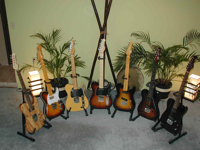Hi, new to the forum, and looking for an ASAT classic. I was wondering if there are any years that are particularly good or bad relative to these guitars. I'm either going to buy used or order one exactly the way I want it.
I was looking recently at a 1993 in very good shape, but not sure if there are big differences between that one and some of the newer models that I've tried.
Thanks!
Good years for ASATs
-
westsideduck

- Posts: 216
- Joined: Fri Feb 26, 2010 6:12 pm
- Location: Buffalo New York
Re: Good years for ASATs
I like the early Classics with the metal pickguards myself but it's a personal preferance, It would be nice if you could hold both in your hand before making a decision but I know that's not always possible. Here's a quote by another member regarding the change in pickups.
"Yes, the ASAT Classic MFD's (just like all other MFD's) have been tweaked from the way they were orginally designed/spec's by Leo. The tweaks seem innocent enough on the surface but they still have a fairly significant effect on tone. Just like all other MFD's, G&L switched from plain enamel insulated wire to poly insulated coil wire. Seems like this shouldn't matter...but it does. You see insulation is a dielectric and therefore ends up acting as a capacitor inside the tightly wound layers of coil wire. Enamel would coils have a different capacitance compared to poly wound coils. Also, the manner in which you wind a coil has a quite a bit to do with the capacitance a coil will end up with. When you random (or scatter) wind a coil, you get less capacitance. This is how the vast majority of the pre-BBE era G&L's pickups are wound...which is by hand. Due to the crudeness of the hand-winding process you get a very random pattern to the wind which ends up being a good thing. When you layer wind (machine only) a coil you get a very neat and tidy appearance but more capacitance. The more Capacitance the less treble frequencies...this is fact! While it is alleged that G&L still "hand-winds" pickups...it must be on a very limited basis because every modern G&L pickup I inspect is very obviously wound by a machine. No human can wind like the coils I've been inspecting over the past several years coming out of the factory.
As a side note, G&L did experiment with machine winders in the 80's. Leo was well aware of the capacitance problems associated with layer winding a coil so the plan was to figure out a way to get them to wind in a manner more consistent with the hand winding random method. This turned out to be much more easier said than done and the machine winders they had procured turned out to not be capable of handling the random winding process without a lot of human intervention so they were abandoned. The vast majority (95%) of all pre-BBE G&L pickups are hand wound.
Also, sometime in 1992...the turn count of the ASAT Classic pickups got bumped up. I don't know exactly when this happened but I've noticed that the DC-R's of 1992 and later ASAT Classic pickups is on average higher than the 1990-1991 pre-BBE pieces. The way you accomplish the higher DC-R is to wind more wire on the coil form. More copper = more resistance = more output = less treble. "
Hope that helps a bit
gary
"Yes, the ASAT Classic MFD's (just like all other MFD's) have been tweaked from the way they were orginally designed/spec's by Leo. The tweaks seem innocent enough on the surface but they still have a fairly significant effect on tone. Just like all other MFD's, G&L switched from plain enamel insulated wire to poly insulated coil wire. Seems like this shouldn't matter...but it does. You see insulation is a dielectric and therefore ends up acting as a capacitor inside the tightly wound layers of coil wire. Enamel would coils have a different capacitance compared to poly wound coils. Also, the manner in which you wind a coil has a quite a bit to do with the capacitance a coil will end up with. When you random (or scatter) wind a coil, you get less capacitance. This is how the vast majority of the pre-BBE era G&L's pickups are wound...which is by hand. Due to the crudeness of the hand-winding process you get a very random pattern to the wind which ends up being a good thing. When you layer wind (machine only) a coil you get a very neat and tidy appearance but more capacitance. The more Capacitance the less treble frequencies...this is fact! While it is alleged that G&L still "hand-winds" pickups...it must be on a very limited basis because every modern G&L pickup I inspect is very obviously wound by a machine. No human can wind like the coils I've been inspecting over the past several years coming out of the factory.
As a side note, G&L did experiment with machine winders in the 80's. Leo was well aware of the capacitance problems associated with layer winding a coil so the plan was to figure out a way to get them to wind in a manner more consistent with the hand winding random method. This turned out to be much more easier said than done and the machine winders they had procured turned out to not be capable of handling the random winding process without a lot of human intervention so they were abandoned. The vast majority (95%) of all pre-BBE G&L pickups are hand wound.
Also, sometime in 1992...the turn count of the ASAT Classic pickups got bumped up. I don't know exactly when this happened but I've noticed that the DC-R's of 1992 and later ASAT Classic pickups is on average higher than the 1990-1991 pre-BBE pieces. The way you accomplish the higher DC-R is to wind more wire on the coil form. More copper = more resistance = more output = less treble. "
Hope that helps a bit
gary
-
yowhatsshakin

- Posts: 3340
- Joined: Tue Feb 09, 2010 8:00 am
- Location: Seattle
Re: Good years for ASATs
Check out Greg Gagliano's G&L section on his website and especially what he has to say about the '90 triple bound ASAT Classic.
- Jos
- Jos